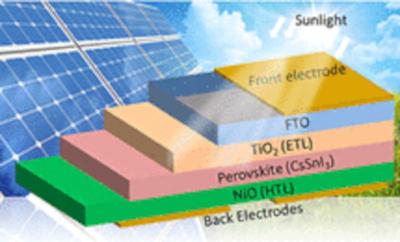Scientists from the Nanjing University of Aeronautics and Astronautics in China and University of Okara in Pakistan have simulated a solar cell based on an absorber using a CsSnI3 perovskite material, which is an inorganic perovskite that has low exciton binding energy, a high absorbance coefficient, and an energy bandgap of 1.3 eV.
The researchers used the SCAPS-1D solar cell capacitance software, which is a simulation tool for thin-film solar cells developed by the University of Ghent in Belgium, to simulate several cell designs with different electron transport layers (ETLs) and hole transport layers (HTLs). Through a series of simulations, the team found that the best possible cell configuration was provided by a device based on a substrate made of fluorine-doped tin oxide (FTO), a titanium oxide (TiO2) ETL, the CsSnI3 absorber, an HTL based on nickel(II) oxide (NiOx), and back electrodes.
The team explained that the perovskite CsSnI3 thickness of 1,250 nm was found optimum for obtaining the highest performance with each ETL and HTL thickness of about 50 nm. The absorber layer with around 1200−1300 nm thickness, TiO2, and NiO with 50 nm thicknesses are considered favorable to obtain high PV efficiency.
The best-performing device built with this architecture achieved an efficiency of 31.09%, an open-circuit voltage of 1.084 V, a short-circuit current of 31.17 mA/cm2, and a fill factor of 88.68%. The researchers said the performance depended mainly on the absorber thickness, the perovskite material's energy bandgap, the acceptor level density, and the cell's central trap energy levels.


